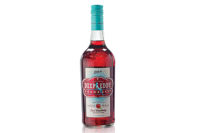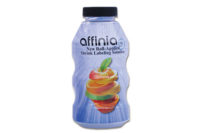For beverage labels, the retail shelf might feel like being in the hot seat on an episode of “Who Wants to be a Millionaire.” The spotlight is on, the suspenseful music is playing and pressure is building as it’s time for the shopper to make a critical decision — to buy or not to buy?
Although it’s not always top of mind, labels face a lot of pressure to help sell a beverage and encourage repeat purchases. Shoppers look to labels for information about the product, durability and a sense of quality or style. Therefore, beverage manufacturers face the challenge of selecting the right label for their products that will live up to shopper expectations.
“Our customers/prospects want products that especially meet three criteria: printability, durability [and] cost,” says Bruce Gordon, product services manager for Arjobex America, Charlotte, N.C.
Lucky for beverage-makers, label suppliers have multiple products to choose from, depending on their customers’ needs, and each material ranges in popularity for its own reasons.
For beverage applications, Fort Dearborn Co. receives many requests for film-based labels due to their durability and moisture resistance, says Gwen Chapdelaine, marketing director for the Elk Grove, Ill.-based company.
“Wet strength and synthetic films are popular due to their durability and water-resistance performance characteristics while providing an upscale label look,” she adds. “Shrink sleeves are also a popular option to help beverages differentiate themselves on shelf by combining shape and color for 360-degree, eye-catching beverage graphics. This combination creates product distinction and visual appeal not achievable with other label formats.”
Louis Iovoli, vice president of strategic partnerships for Hammer Packaging, Rochester, N.Y., agrees that shrink sleeves are a popular option for the beverage industry. “We see the shrink-sleeve category as a very high growth area for the beverage market,” he says. “Most brands like the extra real estate this decorating method has to offer. They also like the uniqueness of the bottle designs they can use.”
Shrink sleeves have the ability to conform to any shape, Iovoli says; therefore, odd-shaped bottles are not an issue. Pressure-sensitive labels also are a good option for custom-shaped bottles, but they provide less real estate for information and graphics, he adds.
In addition to shrink-sleeve and pressure-sensitive labels, Fort Dearborn’s Chapdelaine adds that die-cut, roll-fed and cut-and-stack labels can accommodate odd-shaped beverage bottles.
Drinktec, a trade show for the beverage and liquid food industries, affirms the popularity of shrink sleeves, noting a trend toward wrap-around plastic foil and sleeve labels for PET containers. Modern shrink sleeves work on virtually everything — even container shapes that previously were considered impossible to label, according to a Drinktec press release.
The trade show also cites a market survey conducted by labeling association Finat, which states that self-adhesive labels now account for 55 percent of all labels used. The wide field of self-adhesive applications combined with the diversity of finishes they offer — such as embossed, varnished or laminated — make them an excellent choice for high-quality labels, according to the Drinktec release.
Durable and upscale
In the beverage industry, whether they’re shrink-sleeve, cut-and-stack, roll-fed or pressure-sensitive, all types of labeling materials are expected to “hold their own,” when it comes to durability.
“The material must be durable not only for the end-use product but durable throughout production processes,” Arjobex America’s Gordon says.
For extreme durability, Overnight Labels Inc. offers lamination, says Don Earl, president of the Deer Park, N.Y.-based company, which specializes in pressure-sensitive labels, flexible packaging and shrink sleeves.
Frontier Label Inc.’s most commonly requested material is its white bi-axially oriented polypropylene (BOPP), says John Flowers, prepress and customer service manager for the Greenville, S.C.-based company. Its white and clear BOPP materials are cost-effective for any waterproof, indoor applications, he says. Additionally, Frontier Label’s line of Estate papers are ideal for refrigerated beverages because they have exceptional wet strength and are unlaminated, which gives them a great look and feel for custom or craft applications, he explains.
In addition to durability and moisture-resistance, many customers and consumers are seeking an upscale appearance as well. This can be achieved through design but also via the labeling material itself.
“I cannot overstress how important the quality of the artwork is in terms of making a label look ho-hum or upscale,” Flowers says. “The money spent on a quality design is worth every penny because it is a one-time cost, regardless of how many labels are printed.”
In terms of materials, the company’s Estate and Kraft papers seem to work the best in terms of elevating a product’s feel, he adds. A matte finish, sparing metallic or foil elements, and the company’s new holographic materials also offer a premium appearance, he says.
Labeltronix, Anaheim, Calif., recently launched a new label material called Arctic Shield that conveys a sophisticated look and works well with flexographic or digital offset printing, it says. It is an uncoated, waterproof and chill-proof white paper built to withstand wetness and very cold temperatures, it adds.
Stevens Point, Wis.-based NewPage Corp. also recently introduced its OmniPoint 60-pound heavyweight wet strength label paper to the market. Designed for large glass and plastic containers, the material maintains a premium appearance and performs well throughout all aspects of production, from label printing to die cutting to high-speed label application, the company says.
“We worked closely with our customers to develop a heavyweight label paper solution that meets their needs for consistent quality, durability and label converting performance, while allowing them to deliver the best possible label graphics for their food and beverage brand owner customers,” said David Diekelman, executive director of sales and marketing for specialty papers at NewPage Corp., in a statement.
Fort Dearborn offers clear, metalized and white synthetic materials for cut-and-stack labels that provide an upscale look, durability and moisture resistance, Chapdelaine says. Clear film substrates also are available for pressure-sensitive applications for a more natural and upscale look, she adds. For shrink sleeves, the company’s high-yield white polyethylene terephthlate glycol-modified (PETG) film provides an upscale matte finish that offers high opacity and light-blocking capabilities, she says.
Pressure-sensitive labels offer a high-quality decoration to packages, Overnight Labels’ Earl says. Additionally, the company can incorporate foil decorating as well as rotary silkscreening into a label, he says.
Sustainable labels
Customers remain interested in eco-friendly materials, according to experts. Therefore, many label suppliers have incorporated sustainability into their materials.
Arjobex America, for instance, manufactures bi-axially oriented synthetic high-density polyethylene (HDPE) base film, which is tear-, water-, chemical- and ultraviolet-resistant and ideal for any application that requires durability and exposure to hazardous conditions, Gordon says.
“Our process is eco-friendly (not pulp-based, but oil-based resin), is a No. 2 recyclable HDPE, and we recycle all of our waste film,” he explains. “Our product can be used in label applications for both polyethylene (PE) and polypropylene (PP) plastic containers unlike many other synthetics. Our product has no ‘grain direction,’ thus allowing more flexibility and efficiency in label design and production.”
This year, Frontier Label launched two eco-friendly material options. The first is recycled paper stock, which acts as a standard paper for indoor, dry applications. The second is a Terraskin material, which is made from crushed rock particles and acts like a BOPP in terms of waterproof and flexibility qualities, Flowers says. It also has a more brittle tear pattern, unlike BOPP or vinyl, he adds.
Overnight Labels sees the most interest in its polylactic acid (PLA) sleeves because they are compostable, Earl says. It also offers recyclable polyvinyl chloride (PVC) and PETG materials.
“The most important thing is to have your label and bottle be similar in recyclability and/or compostability,” Earl says. “You don’t want to throw a PET bottle with a PLA label into a landfill when the label is compostable but the bottle will still be in the landfill 100 years from now.”
To maximize its products’ recyclability, Cincinnati-based Spear Inc. developed clear and white film pressure-sensitive label materials that are compatible with the recycling process for PET bottles. After much testing by independently certified lab Plastics Forming Enterprise of Amherst, N.H., Spear’s materials showed acceptable PET haze and
“b” clarity values up to a 50 percent recycled content load and include the blowing of new PET bottles from the recycled flake with acceptable container haze and clarity values, the company says.
Fort Dearborn also offers sustainable materials, including its recycled wet strength paper that contains 10 percent post-consumer waste. The company also offers soy-based inks that contain more than 20 percent soy oil, and its HiColour printing eliminates the need for special Pantone Matching System (PMS) colors, allowing for more effective combination sheet printing that reduces press make-readies and run quantities, Chapdelaine explains. For pressure-sensitive labels, it offers post-consumer recycled (PCR) and tree-free facestocks as well as EarthFirst PLA film for pressure-sensitive and shrink-sleeve applications, she adds.
“We still see an interest in eco-friendly labeling materials, although we see companies lightweighting [and/or] downgauging substrates more often due to the premium of eco-friendly materials,” Chapdelaine says. When lightweighting a bottle, companies should consider downgauging the label as well, if possible, she adds.
In addition to the option of downgauging the label on a lightweight bottle, beverage companies using lightweight primary packaging face a number of considerations.
“They have to decide if the label will be part of the structural integrity of the bottle and give it hoop strength,” Hammer Packaging’s Iovoli explains. “They need to consider recycling impact for PET bottles: What label is easiest for the processes? They also have considerations regarding shipping and how the label will look after distribution.”
The company also must consider the weight of the bottle versus the weight of the label and how the two different materials complement each other, suggests Frontier Label’s Flowers.
“I would not recommend, for instance, putting an Estate material on a thin, plastic bottle; the label may weigh more than the bottle itself,” he explains. “Labels should be an addition, a gesture, a commentary on the product. … Labeling is intended to speak on behalf of a product, not be the product you purchase. A lightweight bottle, say of a thin glass or metal, would do well with a stock paper or BOPP. A heavy bottle (wine, growler) would do well with a metallic or Estate [material] because the product is weightier or grander, so the label material should reflect that.”
Future considerations
Whether a beverage manufacturer uses a lightweight bottle or not, it’s clear that a lot of options exist for companies today.
“In the past, it was easier to define decorating styles and label material because the choice of bottling was much less diverse,” Hammer Packaging’s Iovoli says. “Today and in the future, as a converter of materials, we have to be very adaptive to the ever-changing packaging styles that are being developed. Each client has a different reason for their direction. Some want thin walls and reduced resin; others [want] glass to show quality and rigidness; others [want] shape to depict a fruit, etc. The material we need today has to meet the package need.”
Overnight Labels’ Earl adds that it’s up to the beverage company to decide how they want to convey their message and then match the label material and its specific attributes to that message.
“The considerations for a lightweight bottle are the same as for a glass bottle: How can I attract attention to my product to sell more product?” he explains. BI






